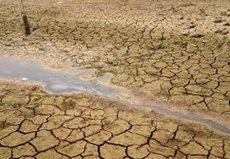California prepares $1-bn package for drought relief
19 Mar 2015
As California braces for a fourth consecutive year of drought, Governor Jerry Brown and legislative leaders are preparing to reveal a $1-billion relief plan.
 Not only is the state facing its fourth-worst drought in recorded history which has lasted four years now, but weathermen see no prospect of significant rain or snow this winter (See: California will run out of water in a year, warns NASA expert).
Not only is the state facing its fourth-worst drought in recorded history which has lasted four years now, but weathermen see no prospect of significant rain or snow this winter (See: California will run out of water in a year, warns NASA expert).
Californians face the prospect of stricter rationing of water and meagre irrigation deliveries.
This will mark the second consecutive year in which the state legislature has had to act on emergency drought relief. In 2014, Brown signed a $687.4 million drought package, which offered aid to communities facing acute water shortages and food and housing assistance to those harmed by the drought.
Brown, along with Senate President Pro Tem Kevin De León and Assembly Speaker Toni Atkins (D-San Diego) will introduce emergency drought legislation, Brown's office said on Wednesday evening. The office did not elaborate on details of the plan.
The Legislature also crafted a $7.5-billion water bond that was approved by voters last November. Most of those funds would go to longer-term projects to bolster the state's water infrastructure.
The move comes amid growing concern about the state's dry conditions.
On Tuesday, the State Water Board tightened its watering restrictions, telling urban agencies to limit the number of days when residents can water their yards.
They also warned that they will impose tougher restrictions in coming months if local agencies don't ramp up conservation efforts.
"We are not seeing the level of stepping up and ringing the alarm bells that the situation warrants," said Felicia Marcus, chairwoman of the State Water Resources Control Board.
The board also warned it would impose stricter limits if local agencies don't make faster progress in their conservation efforts.
Some relief?
The state's water situation is in some respects slightly better than it was a year ago. Precipitation in key watersheds in Northern California is 81 per cent of normal for the date. Shasta Lake, California's largest reservoir, is 58 per cent full, compared with 45 per cent a year ago.
Lake Oroville is half full, compared with 45 per cent at this time last year.
Customers of the State Water Project, which delivers supplies from Northern California to Southland cities, will get 20 per cent of their contract requests, compared with only 5 per cent in 2014.
But some smaller reservoirs in the southern Sierra Nevada have less in reserve than they did last spring. And most troubling to water managers is the state-wide snowpack. At 12 per cent of average, it has all but disappeared. At this time last year it was 28 per cent of average.
The mountain snowpack acts as a natural reservoir that in a normal year can hold much as a third of the state's water supply, slowly releasing it throughout the spring as seasonal water demand rises. This year that release will be a trickle.













.jpg)






.jpg)









